 Technology peripherals
Technology peripherals
 AI
AI
 AIGC education industry panoramic report: AI teaching assistants and tutors come true, and learning machines usher in new opportunities
AIGC education industry panoramic report: AI teaching assistants and tutors come true, and learning machines usher in new opportunities
AIGC education industry panoramic report: AI teaching assistants and tutors come true, and learning machines usher in new opportunities
After a year of rapid iteration, the industry already has answers as to which industries generative AI will be the first to be implemented.
The education field is not only listed as one of the key applications by OpenAI, but has also become a key direction for the layout of large domestic model manufacturers.
Advances in generative AI technology demonstrate increasing human interaction with large models. The large model continuously learns the human way of thinking through training, and humans also gain new inspiration and knowledge in the dialogue with the large model.
This process is the ideal state pursued by education and is also the embodiment of "teaching and learning". Generative AI is highly compatible with education, making education an excellent application field.
After determining the landing place, the more important thing is how to combine technology and education to achieve the role of empowering the latter.
What achievements has AIGC empowered education achieved in the past year? How will AIGC disrupt education? In the future, what new trends will emerge in education due to the development of generative AI?
In the "AIGC Education Industry Panoramic Report", the Qubit Think Tank gave a systematic review after exchanges within and outside the industry.
Core viewpoints include:
- The large education model has become the industrial base, and "AI native" ideas have penetrated into all aspects of the industry
- AI intelligence helps "personalized learning" "Puhui, each student has his or her own dedicated AI tutor
- AI intelligent agent transforms into a teacher assistant to help teachers complete ability advancement
- Interdisciplinary understanding builds high-level capabilities of a large education model, It will become the core competitiveness of model layer players
- Educational large-scale models are evolving towards multi-modality, and landing products tend to be rich
- In the next 3-5 years, AI PC will be the mainstream hardware product, and GenAI XR will empower Ability to innovate education
- The "concrete" development of AI intelligence, embodied intelligent brain-computer interface to achieve human-computer integration
......
Let's look at the specific details one by one .
The educational technology field fully embraces generative AI
Generative AI leads us into the AI2.0 era. By learning massive amounts of data, AI has demonstrated amazing generative capabilities. The answers it generates are more in line with human language communication and can stimulate people's thinking consciousness to a certain extent.
In the field of educational technology, the most intuitive change is the “AGI” product. From learning machines to APPs to smart teaching, the educational technology field has access to GPT products to a certain extent.
During May-June 2023, the GMV of the AI learning machine equipped with iFlytek’s Spark cognitive large model increased by 136% and 217% year-on-year respectively. The AI learning machine also became the first choice for JD.com and JD.com during last year’s Double Eleven. Tmall dual-platform sales champion.

The big model of education has become the foundation of the industry, and the idea of "AI native" has penetrated into all aspects of the industry
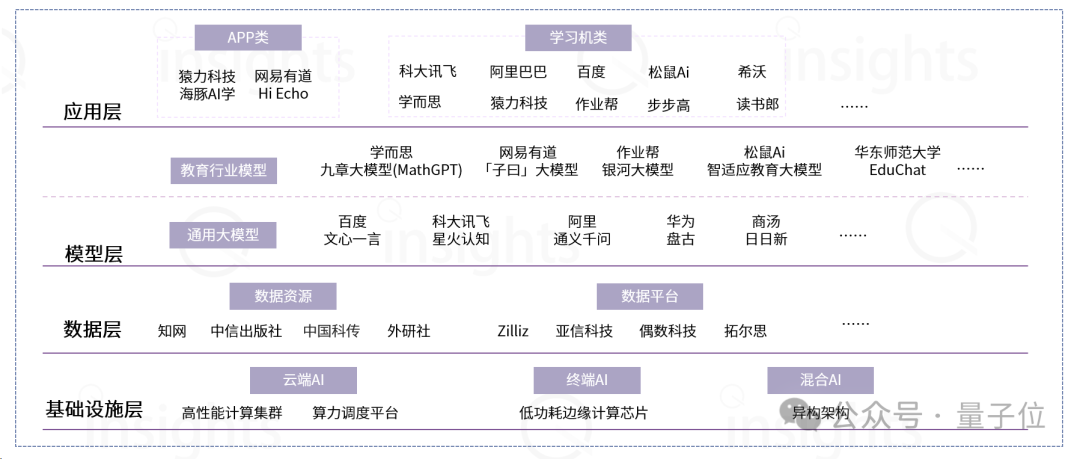
Oriented to K- 12 groups of AI learning machines are fully introduced to the market
The learning machine is a unique educational technology product in the domestic market. With the support of large models, the learning machine has achieved a rebound in sales by providing incremental value to users.
From a product perspective, when doing AIGC education in China, most large companies choose to equip learning machines with large models to increase product sales by providing incremental value to users.
The learning machine track is currently highly competitive, and the emergence of generative AI is expected to build new competition barriers for learning machines.
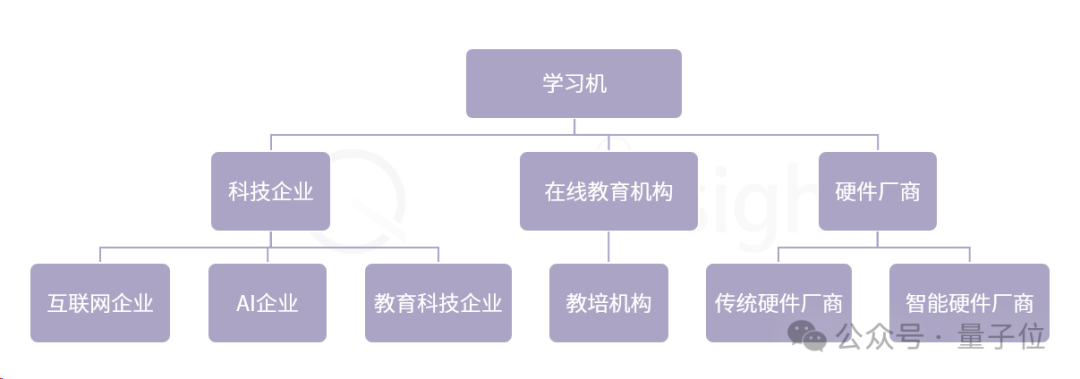
From a user perspective, the audience for learning machines is K-12 people. The willingness to pay for this group of people comes from their parents.
In primary school, parents value the development of their children’s interests; while in middle school, parents value whether products can improve their children’s academic performance.

Language learning APP product experience has been upgraded, and market feedback is better than expected
Language learning APP has performed well in overseas markets, and leading products have been integrated GPT4. Domestic language APPs also have access to large models, and the interactive question and answer with generative AI technology has been substantially improved compared to previous generation products.
From a product perspective, companies that enter the AIGC education track through software access general large models and use their own accumulated education data for fine-tuning training, focusing on APP products.
This type of product has the most positive market feedback among large-model products used in education due to its upgraded dialogue experience.
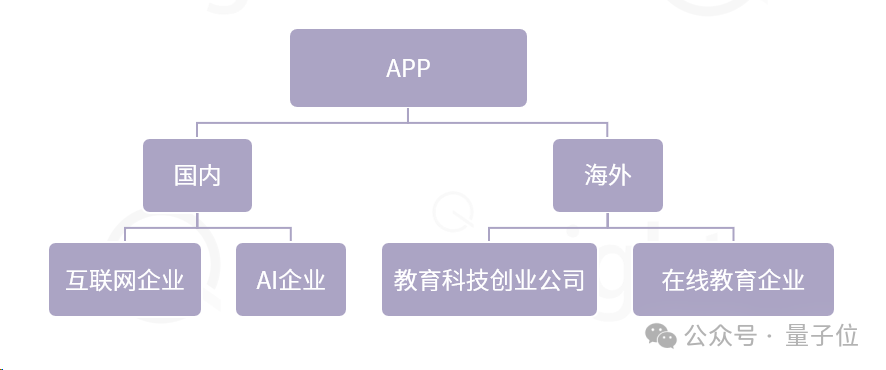
From the perspective of audience demand, currently it is mainly college students and office workers. Among this group of people, college students also have the need to improve their grades, while office workers do not have the need to improve their grades. Learning languages is more out of work needs or interest. For these two groups of people, user retention rate is the key. Based on this, product design will pay more attention to user experience and marketing strategies.
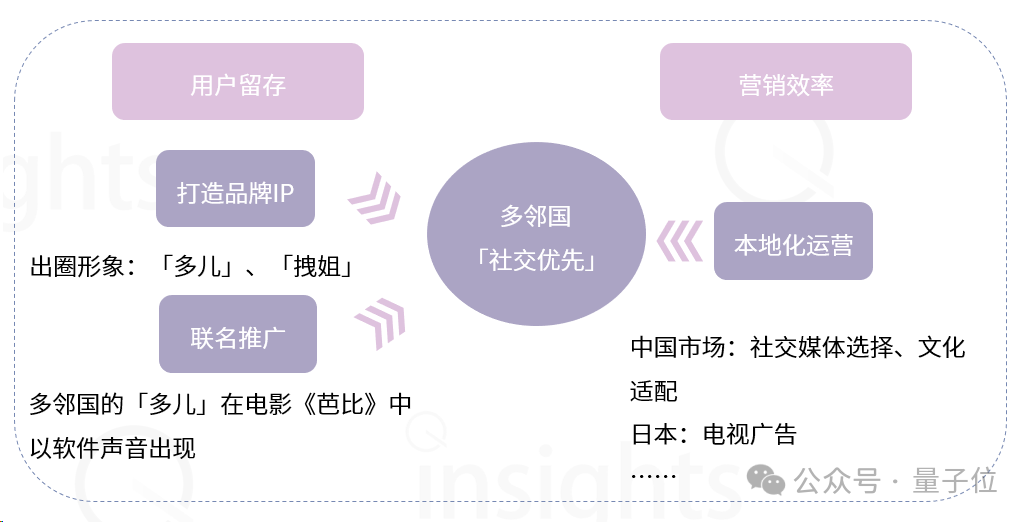
Generative AI has become a new driving force for educational reform
The combination of education and technology has a long history. With the rise of the Internet in the 1990s, the era of online education began. Entering the 21st century, adaptive learning has become a hot topic in overseas education through the introduction of intelligent systems. After 2010, with the development of artificial intelligence technology, technologies such as knowledge graphs were used in the field of education.
At every stage, education will be combined with current technology to solve the problems faced in education.
In the era of generative AI, the integration of technology and education has had a subversive effect on teachers and students, the two core roles of education. AI has been integrated into the daily lives of teachers and students in a new form - Agent, changing their learning and working status on the basis of providing teaching and learning assistance.
The combination of AI and education has also made technology companies account for an increasing share of the education market, and generative AI capabilities have become a new competitive point.
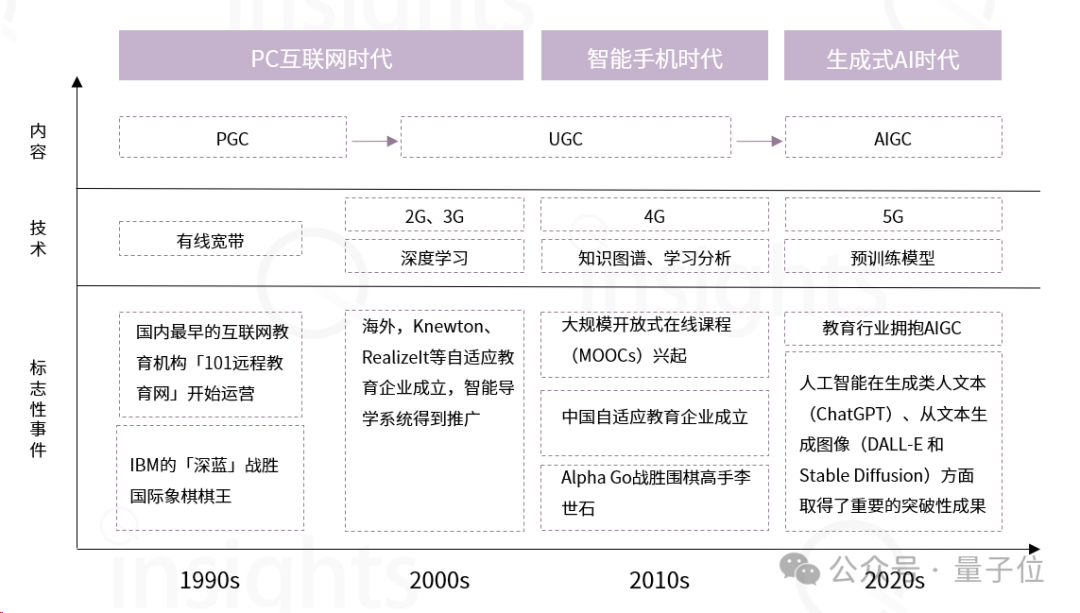
AI intelligence helps "personalized learning" be inclusive, and each student has his or her own AI tutor
AI intelligence provides students with personalized learning Specialized teaching: mainly reflected in the after-school stage, which can effectively achieve one-to-one learning and tutoring.
In the era of generative AI, the biggest opportunity for educators is the universal benefit of adaptive education.
Before generative AI, the use of personalized learning in the education field was an extremely costly matter. It put forward high requirements for schools and families, requiring advanced hardware equipment and more teachers. and teaching venues.
After the emergence of generative AI, the development of AI agents is within reach. AI agents can serve as each student's personal assistant, accompanying students in their studies anytime and anywhere.
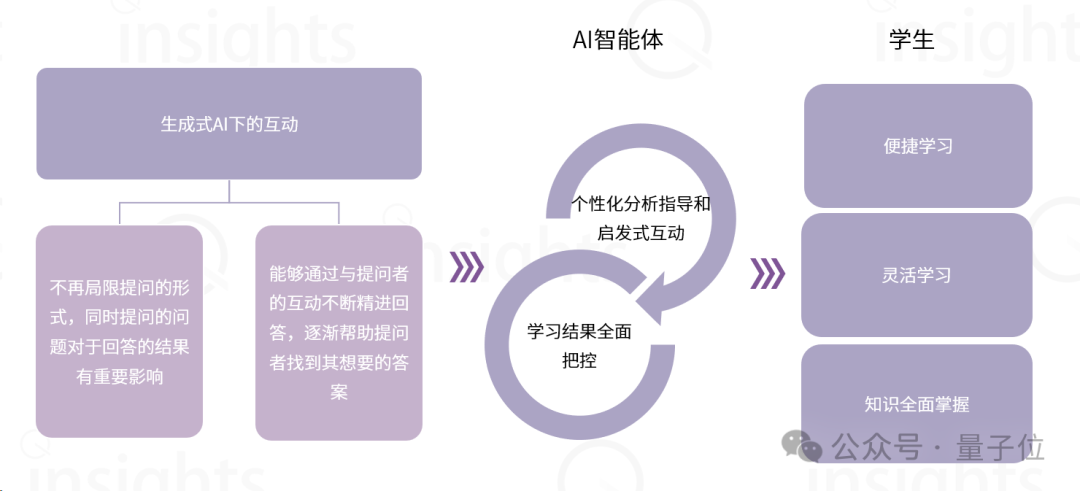
AI intelligent agent transforms into a teacher’s assistant to help teachers complete ability advancement
In terms of tool use, AI intelligent agents reduce teachers’ learning costs and provide It provides almost zero-threshold usage. In the work process, AI agents help teachers generate courseware more efficiently and provide teaching design ideas, etc.
AI agents release teachers’ productivity to a certain extent. More teachers’ energy can be used to improve students’ literacy. Teachers’ responsibilities gradually shift from teaching and solving doubts to educating people, and the focus expands from focusing on student performance to Pay attention to students' mental state.
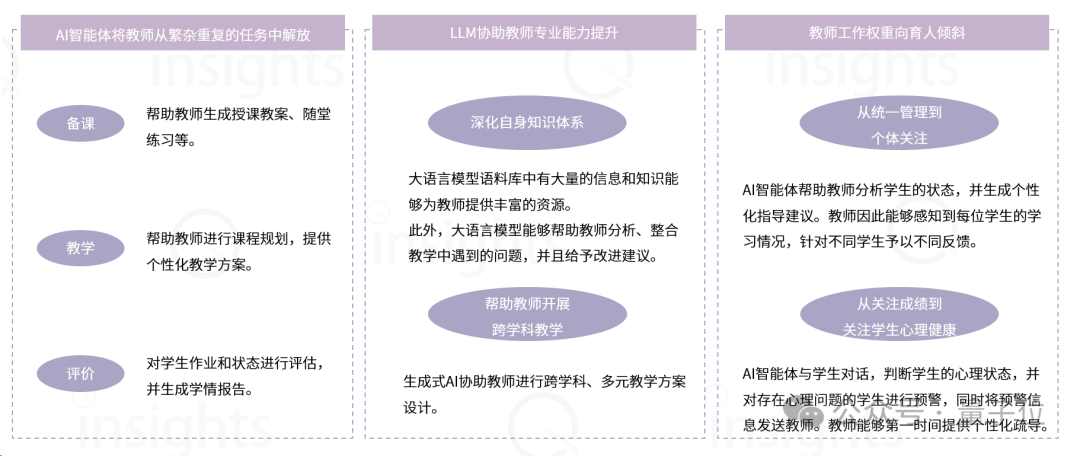
Changes and challenges coexist
Educational large models mainly face three types of challenges during the implementation process:
1) Data quality; 2) Illusion Question; 3) Values alignment.
Challenge 1: Lack of high-quality data leads to insufficient model generalization
Low-quality text data, including too much repeated content, low-quality articles, etc., not only affects the model training effect, but also causes It must be a waste of computing power.
The limited access to educational data, especially teaching behavior data, and the lack of high-quality educational annotation data result in limited trainable educational artificial intelligence models. Therefore, data quality becomes key to the development of large educational models.
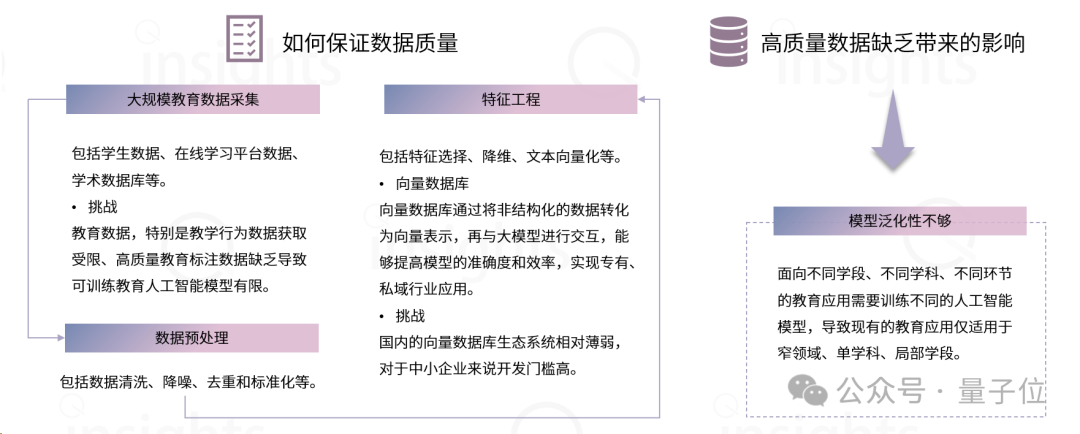
Challenge 2: The large-scale application of large models in education needs to solve the problem of illusion
The most critical thing about large models in the field of education is to ensure the accuracy of model answers gender and value orientation.
Accuracy is reflected in mathematical problems. The current accuracy of large education models on mathematical problems is low and cannot yet reach a level that can be applied on a large scale. In answering some high-level mathematics questions, the accuracy rate is generally below 50%.
In the field of education, the problem of hallucinations can be solved through question and answer reasoning based on search-augmented generation (RAG) and question and answer reasoning based on prompt word engineering.
Challenge 3: Values alignment is the only way to implement the big education model
For value orientation, it mainly refers to whether there are extreme and inconsistent remarks in the answers of the big model. , and even some error guidance occurred.
In terms of value alignment, the commonly used method is RLHF (Human Feedback Reinforcement Learning), which allows a language model trained on a general text data corpus to be aligned with complex human values.
In addition, since the target group is students, the review of large education models will be more stringent. AI-generated content will also be reviewed manually to further filter out low-quality content and ensure that there are no misdirections in the generated content.
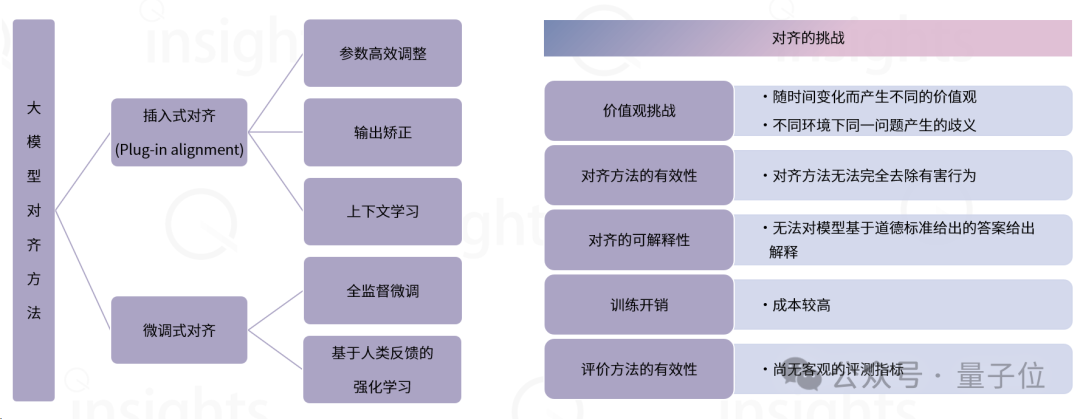
Industry changes bring new trends
Interdisciplinary understanding builds high-level capabilities in large education models, which will become the core competitiveness of model layer players
In the domestic market, self-built large models have become an essential capability for industry players.
In the field of education, companies entering AIGC all choose to build their own large models. The difference lies in the capabilities of the models. Some companies choose to provide comprehensive tutoring, while others choose to make breakthroughs in a single subject first. At present, the enterprise's self-built large-scale education model has the ability to integrate interdisciplinary knowledge. In the future, interdisciplinary understanding will become the embodiment of high-level capabilities in self-built large models.
Interdisciplinary large models are a technical bridge between connecting knowledge and solving practical problems.
Interdisciplinary large models have higher value among student groups who need to master a rich knowledge system, such as middle school students and college students. For middle school students, there are many subjects to study. Students' usual learning method is to practice a large number of questions and memorize them repeatedly, but there is no "connection-transfer-through" between knowledge points. Therefore, it is easy to forget after taking the test and cannot be combined with practical applications. This is also a problem that the education field has always wanted to solve.
The interdisciplinary large model solves the problem of helping students truly integrate knowledge points and be able to use knowledge to solve real-life problems.
Educational large models are evolving towards multi-modality, and landing products tend to be rich
Multi-modal large models integrate information from different modalities, which can promote more accurate and comprehensive understanding and reasoning .
In the field of education, by analyzing data such as students’ writing, painting, and language expression, agents can better understand students’ learning status and needs, and provide personalized guidance and suggestions. By analyzing teachers' teaching data and classroom conditions, it can help teachers manage students in real time and complete teaching work efficiently.
The development of large multi-modal models will be accompanied by the continuous upgrading of hardware, and the product form of AI agents will also be iterated accordingly. As the data dimension increases, AI agents will gradually become users’ “exclusive” partners.
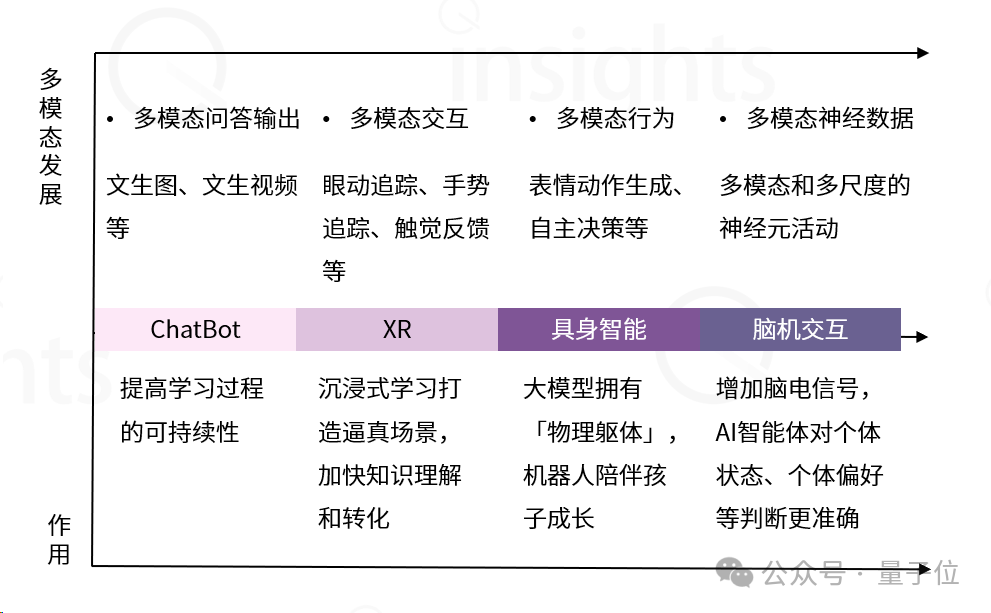
AI PC will be the mainstream hardware product in the next 3-5 years, GenAI XR will empower innovative education
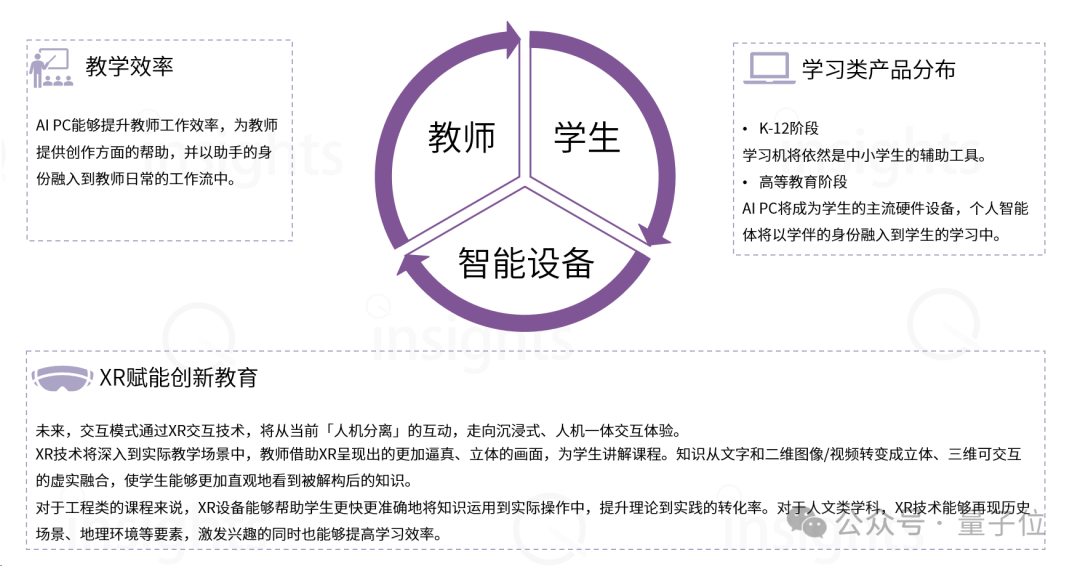
AI The "concrete" development of intelligent agents, embodied intelligent brain-computer interfaces to achieve human-machine integration
AI agents will develop toward concreteness, moving from Internet AI to Embodied AI.
Currently, AI agents have become the mainstream form of large model applications, completing tasks through "human-machine collaboration", with AI agents undertaking most of the work.
AI intelligence now exists in the form of software in various smart devices, and some products already have digital human images to enhance the realism of interactions.
In the future, Agent A will further evolve from the virtual world to the real world and have a physical image. Embodied intelligence that "combines soft and hard" will further expand the scope of the agent's capabilities. At this stage, the AI agent, in the form of a robot, empowers educational practice scenarios and has stronger companionship attributes.
In the brain-computer era, the interaction between AI agents and humans will be more in-depth. AI agents will be more accurate in understanding human intentions and analyzing states, and will be able to intervene in people with learning disabilities. The integration of man and machine will reach new heights.
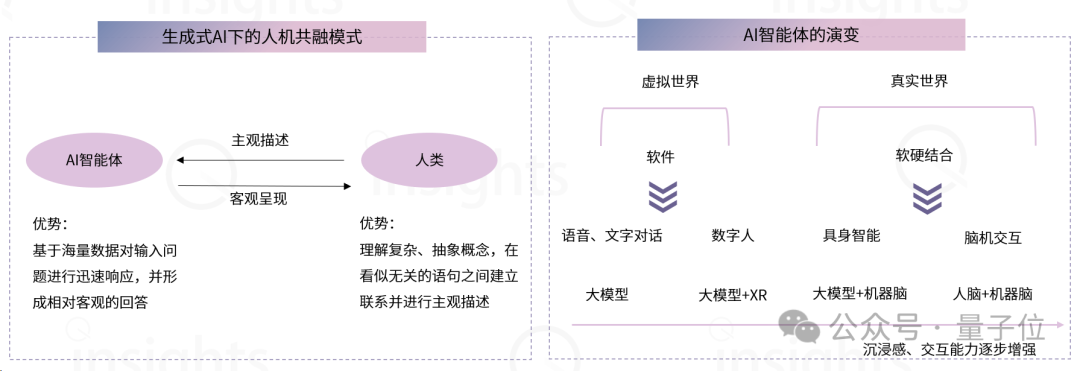
Specific report details and a collection of representative player cases can be found in the comment area below.
The above is the detailed content of AIGC education industry panoramic report: AI teaching assistants and tutors come true, and learning machines usher in new opportunities. For more information, please follow other related articles on the PHP Chinese website!

Hot AI Tools

Undresser.AI Undress
AI-powered app for creating realistic nude photos

AI Clothes Remover
Online AI tool for removing clothes from photos.

Undress AI Tool
Undress images for free

Clothoff.io
AI clothes remover

AI Hentai Generator
Generate AI Hentai for free.

Hot Article

Hot Tools

Notepad++7.3.1
Easy-to-use and free code editor

SublimeText3 Chinese version
Chinese version, very easy to use

Zend Studio 13.0.1
Powerful PHP integrated development environment

Dreamweaver CS6
Visual web development tools

SublimeText3 Mac version
God-level code editing software (SublimeText3)

Hot Topics
 1376
1376
 52
52
 Unifying characters and changing scenes, PixVerse, a video generation artifact, has been played out by netizens, and its super consistency has become a 'killer move'
Apr 01, 2024 pm 02:11 PM
Unifying characters and changing scenes, PixVerse, a video generation artifact, has been played out by netizens, and its super consistency has become a 'killer move'
Apr 01, 2024 pm 02:11 PM
Another double click is the debut of a new feature. Have you ever wanted to change the background of a character in a picture, but the AI always produces the effect of "the object is neither the person nor the object". Even in mature generation tools such as Midjourney and DALL・E, some prompt skills are required to maintain character consistency, otherwise the characters will change around and you will not achieve the results you want. However, this time it’s your chance. The new "Character-Video" function of the AIGC tool PixVerse can help you achieve all this. Not only that, it can generate dynamic videos to make your characters more vivid. Enter a picture and you will be able to get the corresponding dynamic video results. On the basis of maintaining the consistency of the characters, the rich background elements and character dynamics allow the generated results to be
 Xiaomi Photo Album AIGC editing function officially launched: supports intelligent image expansion and magic elimination Pro
Mar 14, 2024 pm 10:22 PM
Xiaomi Photo Album AIGC editing function officially launched: supports intelligent image expansion and magic elimination Pro
Mar 14, 2024 pm 10:22 PM
According to news on March 14, Xiaomi officially announced today that the AIGC editing function of Xiaomi Photo Album is officially launched on Xiaomi 14 Ultra mobile phones, and will be fully launched on Xiaomi 14, Xiaomi 14 Pro and Redmi K70 series mobile phones within this month. The AI large model brings two new functions to Xiaomi Photo Album: Intelligent Image Expansion and Magic Elimination Pro. AI smart image expansion supports the expansion and automatic composition of poorly composed pictures. The operation method is: open the photo album to edit - enter cropping and rotation - click smart image expansion. Magic Elimination Pro can seamlessly eliminate passers-by in tourist photos. The method of use is: open the photo album to edit - enter Magic Elimination - click Pro in the upper right corner. At present, Xiaomi 14Ultra machine has launched intelligent image expansion and magic elimination Pro functions.
 ChatGPT nemesis, introduces five free and easy-to-use AIGC detection tools
May 22, 2023 pm 02:38 PM
ChatGPT nemesis, introduces five free and easy-to-use AIGC detection tools
May 22, 2023 pm 02:38 PM
Introduction After the launch of ChatGPT, it was like Pandora's box was opened. We are now observing a technological shift in many ways of working. People are using ChatGPT to create websites, apps, and even write novels. With the hype and introduction of AI-generating tools, we have also seen an increase in bad actors. If you follow the latest news, you must have heard that ChatGPT has passed the Wharton MBA exam. To date, ChatGPT has passed exams covering fields ranging from medicine to law degrees. Beyond exams, students are using it to submit assignments, writers are submitting generative content, and researchers can produce high-quality papers by simply typing in prompts. To combat the abuse of generative content
 The marketing effect has been greatly improved, this is how AIGC video creation should be used
Jun 25, 2024 am 12:01 AM
The marketing effect has been greatly improved, this is how AIGC video creation should be used
Jun 25, 2024 am 12:01 AM
After more than a year of development, AIGC has gradually moved from text dialogue and picture generation to video generation. Looking back four months ago, the birth of Sora caused a reshuffle in the video generation track and vigorously promoted the scope and depth of AIGC's application in the field of video creation. In an era when everyone is talking about large models, on the one hand we are surprised by the visual shock brought by video generation, on the other hand we are faced with the difficulty of implementation. It is true that large models are still in a running-in period from technology research and development to application practice, and they still need to be tuned based on actual business scenarios, but the distance between ideal and reality is gradually being narrowed. Marketing, as an important implementation scenario for artificial intelligence technology, has become a direction that many companies and practitioners want to make breakthroughs. Once you master the appropriate methods, the creative process of marketing videos will be
 AIGC innovates customer service, and Weiyin builds a '1+5' generative AI intelligent product matrix
Sep 15, 2023 am 11:57 AM
AIGC innovates customer service, and Weiyin builds a '1+5' generative AI intelligent product matrix
Sep 15, 2023 am 11:57 AM
Artificial intelligence technology, which consists of natural language processing, speech recognition, speech synthesis, machine learning and other technologies, has been widely recognized in various industries. Being at the forefront of AI applications, starting from the end of 2022, Weiyin has continued to witness the surprises brought by AIGC technology, and is also fortunate to participate in this technology wave that covers the world. After training, testing, tuning and application, Weiyin combined its rich customer service industry experience with powerful large model capabilities to develop a generative AI customer service robot suitable for both the agent side and the business side. At the same time, Weiyin also connected the underlying capabilities with Weiyin Vision series of intelligent products, ultimately forming a "1+5" Weiyin generative AI intelligent product matrix. Among them, "1" is the large model service platform for Weiyin's independent training.
 An AI entrepreneurial idea suitable for programmers
Apr 09, 2024 am 09:01 AM
An AI entrepreneurial idea suitable for programmers
Apr 09, 2024 am 09:01 AM
Hello everyone, I am Casson. Many programmer friends want to participate in the development of their own AI products. We can divide the product form into four quadrants based on the "degree of process automation" and "degree of AI application". Among them: the degree of process automation measures "how much of the service process of the product requires manual intervention" and the degree of AI application measures "the proportion of AI application in the product". First, limit the ability of AI to process an AI picture application. The user passes the application within the application. The complete service process can be completed by interacting with the UI, resulting in a high degree of automation. At the same time, "AI image processing" relies heavily on AI capabilities, so AI application is high. The second quadrant is the conventional application development field, such as developing knowledge management applications, time management applications, and high process automation.
 Explore why artificial intelligence is used in education
Jan 26, 2024 am 11:45 AM
Explore why artificial intelligence is used in education
Jan 26, 2024 am 11:45 AM
The application of artificial intelligence in education can greatly change the education industry. It helps teachers and students quickly access useful information and provides many other benefits. Generally speaking, the ratio of students to teachers in the classroom is relatively high. However, sometimes it is very difficult for a teacher to manage and pay attention to all students at the same time. In the field of education, artificial intelligence can act as an assistant to teachers and provide assistance in various fields. Technology is constantly advancing in every field and is proving to be of huge benefit to education. It is predicted that by 2030, the market size of artificial intelligence in education will reach US$25.7 billion. Children's curiosity is boundless and they ask questions that humans sometimes cannot answer correctly. To satisfy this curiosity, artificial intelligence in education
 Home appliance industry observation: With the support of AI, will whole-house intelligence become the future of smart home appliances?
Jun 13, 2023 pm 05:48 PM
Home appliance industry observation: With the support of AI, will whole-house intelligence become the future of smart home appliances?
Jun 13, 2023 pm 05:48 PM
If artificial intelligence is compared to the fourth industrial revolution, then large models are the food reserves of the fourth industrial revolution. At the application level, it allows the industry to revisit the vision of the Dartmouth Conference in the United States in 1956 and officially begins the process of reshaping the world. According to the definition of major manufacturers, AI home appliances are home appliances with interconnection, human-computer interaction and active decision-making capabilities. AI home appliances can be regarded as the highest form of smart home appliances. However, can the AI-powered whole-house smart model currently on the market become the protagonist of the industry in the future? Will a new competition pattern emerge in the home appliance industry? This article will analyze it from three aspects. Why does the whole house intelligence sound louder than rain? Source: Statista, Zhongan.com, iResearch Consulting, Luotu Technology, National Lock Industry Information Center



